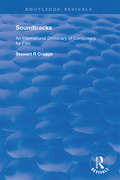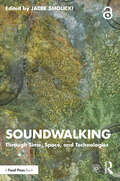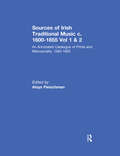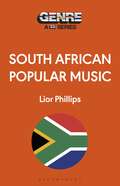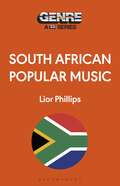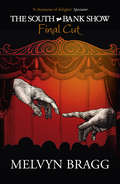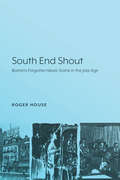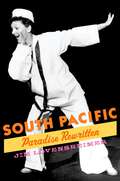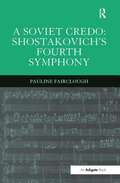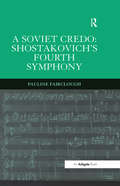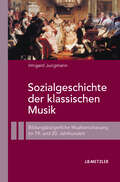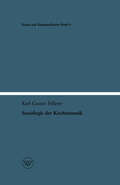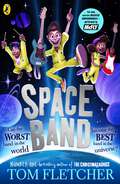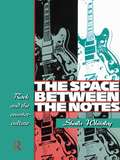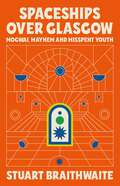- Table View
- List View
Soundtracks: International Dictionary of Composers of Music for Film (Routledge Revivals)
by Stewart R. CraggsFirst published in 1998, music scored for film has only relatively recently received the critical attention which it merits. Many composers in the twentieth century have written works for films or documentaries, a number feeling that this aspect of their output has been undervalued. This dictionary complements other studies which have appeared in recent years which look at the technical and theoretical issues concerned with film music composition. Arranged alphabetically by composer, the volume comprises over 500 entries covering all nationalities. Each entry includes very brief biographical information on the composer, followed by a list of the films (with dates) for which he or she has composed. Details of recordings are also given. The dictionary’s international coverage ensures that it will become a standard reference work for all those interested in the history of twentieth-century music and the development of film.
Soundwalking: Through Time, Space, and Technologies
by Jacek SmolickiSoundwalking brings together a diverse group of contemporary scholars, artists and thinkers in one of the first comprehensive studies of soundwalking – the practice of moving through space while carefully listening to what it has to say – to address urgent challenges and concerns of an environmental, ethical, social and technological nature. Besides gaining insight into the historical development of soundwalking as a scholarly method and artistic genre, the reader will have a chance to learn from emerging voices concerned with this practice, of many different backgrounds and positionalities. Soundwalking demonstrates how attentive listening and walking might help with more careful and responsible navigation through the complex dimensions of our shared environments and entangled histories, often imperceptible on a day-to-day basis. The book encourages scholars, artists, and also those unfamiliar with the concept, to engage with it in their respective fields and subjects of interest as an interdisciplinary method of critical inquiry and a creative mode of communication. This book inspires readers to discover anew the potential of walking and listening, and will be of interest to students, researchers and practitioners in the areas of studies directly concerned with sound and beyond, including environmental humanities, arts, design, landscape architecture, media, and cultural studies.
Soundwalking: Through Time, Space, and Technologies
by Jacek SmolickiSoundwalking brings together a diverse group of contemporary scholars, artists and thinkers in one of the first comprehensive studies of soundwalking – the practice of moving through space while carefully listening to what it has to say – to address urgent challenges and concerns of an environmental, ethical, social and technological nature. Besides gaining insight into the historical development of soundwalking as a scholarly method and artistic genre, the reader will have a chance to learn from emerging voices concerned with this practice, of many different backgrounds and positionalities. Soundwalking demonstrates how attentive listening and walking might help with more careful and responsible navigation through the complex dimensions of our shared environments and entangled histories, often imperceptible on a day-to-day basis. The book encourages scholars, artists, and also those unfamiliar with the concept, to engage with it in their respective fields and subjects of interest as an interdisciplinary method of critical inquiry and a creative mode of communication. This book inspires readers to discover anew the potential of walking and listening, and will be of interest to students, researchers and practitioners in the areas of studies directly concerned with sound and beyond, including environmental humanities, arts, design, landscape architecture, media, and cultural studies.
Sources and Style in Moore’s Irish Melodies
by Una HuntOnce regarded as Ireland’s national bard, Thomas Moore's lasting reputation rests on the ten immensely popular collections of drawing-room songs known as the Irish Melodies, published between 1808 and 1834. Moore drew on anthologies of ancient music, breathing new life into the airs and bringing them before a global audience for the very first time. Recognizing the unique beauty of the airs as well as their symbolic significance, these qualities were often interwoven into the verses providing potent political commentary along with a new cultural perspective. At home and abroad, Moore’s Melodies created a realm of influence that continued to define Irish culture for many decades to come. Notwithstanding the far-reaching appeal and success of the collections, Moore has only recently begun to receive serious attention from scholars. Una Hunt provides the first detailed study of Moore’s Irish Melodies from a combined musical and literary standpoint by drawing on a practical understanding and an unrivalled performance experience of the songs. The initial two chapters contextualize Moore and his songs through a detailed examination of their sources and style while the following chapters concentrate on the collaborative work provided by the composers Sir John Stevenson and Henry Rowley Bishop. Chapters 5 and 6 reappraise musical sources and Moore’s adaptation of these, supported and illustrated by the Table of Sources in the Appendix.
Sources and Style in Moore’s Irish Melodies
by Una HuntOnce regarded as Ireland’s national bard, Thomas Moore's lasting reputation rests on the ten immensely popular collections of drawing-room songs known as the Irish Melodies, published between 1808 and 1834. Moore drew on anthologies of ancient music, breathing new life into the airs and bringing them before a global audience for the very first time. Recognizing the unique beauty of the airs as well as their symbolic significance, these qualities were often interwoven into the verses providing potent political commentary along with a new cultural perspective. At home and abroad, Moore’s Melodies created a realm of influence that continued to define Irish culture for many decades to come. Notwithstanding the far-reaching appeal and success of the collections, Moore has only recently begun to receive serious attention from scholars. Una Hunt provides the first detailed study of Moore’s Irish Melodies from a combined musical and literary standpoint by drawing on a practical understanding and an unrivalled performance experience of the songs. The initial two chapters contextualize Moore and his songs through a detailed examination of their sources and style while the following chapters concentrate on the collaborative work provided by the composers Sir John Stevenson and Henry Rowley Bishop. Chapters 5 and 6 reappraise musical sources and Moore’s adaptation of these, supported and illustrated by the Table of Sources in the Appendix.
The Sources of Beneventan Chant (Variorum Collected Studies)
by Thomas Forrest KellyThe area whose capital was the southern Lombard city of Benevento developed a culture identified with the characteristic form of writing known as the Beneventan script, which was used throughout the area and was brought to perfection at the abbey of Montecassino in the late eleventh century. This repertory, along with other now-vanished or suppressed local varieties of music, give a far richer picture of the variety of musical practice in early medieval Europe than was formerly available. Thomas Forrest Kelly has identified and collected the surviving sources of an important repertory of early medieval music; this is the so-called Beneventan Chant, used in southern Italy in the early middle ages, before the adoption there of the now-universal music known as Gregorian chant. Because it was deliberately suppressed in the course of the eleventh century, this music survives mostly in fragments and palimpsests, and the fascinating process of restoring the repertory piece by piece is told in the studies in this book. A companion volume to this collection also by Professor Kelly details the practice of Medieval music.
The Sources of Beneventan Chant (Variorum Collected Studies)
by Thomas Forrest KellyThe area whose capital was the southern Lombard city of Benevento developed a culture identified with the characteristic form of writing known as the Beneventan script, which was used throughout the area and was brought to perfection at the abbey of Montecassino in the late eleventh century. This repertory, along with other now-vanished or suppressed local varieties of music, give a far richer picture of the variety of musical practice in early medieval Europe than was formerly available. Thomas Forrest Kelly has identified and collected the surviving sources of an important repertory of early medieval music; this is the so-called Beneventan Chant, used in southern Italy in the early middle ages, before the adoption there of the now-universal music known as Gregorian chant. Because it was deliberately suppressed in the course of the eleventh century, this music survives mostly in fragments and palimpsests, and the fascinating process of restoring the repertory piece by piece is told in the studies in this book. A companion volume to this collection also by Professor Kelly details the practice of Medieval music.
Sources of Irish Traditional Music c. 1600-1855: An Annotated Catalogue of Prints and Manuscripts, 1583-1855
by Aloys FleischmanFirst Published in 1998. Irish traditional music is one of the richest treasuries of folk music in the world. Being an oral tradition, much of it has already been lost, and what has been recorded is only partially available in isolated collections. Until now, no composite picture has yet been presented, showing its remarkable range and diversity over four centuries. This volume covers Irish materials in general collections up to 1800 and in Irish collections up to and including Petrie's Ancient Music of Ireland (1855).The purposes of the project are to identify Irish dance tunes and songs; to present the scholar with a mass of material showing the evolution of the Irish vocal and instrumental folk style, period by period, from the earliest recorded tune up to the middle of the last century; to put into circulation many of the splendid airs which were lost but have now been located. Some 6,000 songs and dance tunes are presented, also including Scottish and English tunes. Included are Scottish tunes that were used by 18th-century Irish poets for their verses, and both English and Scottish tunes that are still current among Irish traditional musicians. Tunes of present-day currency which do not seem to be included may still be located by comparing their first 12 notes in the thematic index at the end of the volume.To make the vast array of material readily available, an index allows readers to locate a tune by its melodic incipit, by any of its titles, or by the first line of its text. Unfortunately, the vast majority of Irish songs noted up to the end of the last century lack texts, since the collectors were ignorant of the Irish language. But almost every other facet is covered-provenance, tonality structure, and variants.
Sources of Irish Traditional Music c. 1600-1855: An Annotated Catalogue of Prints and Manuscripts, 1583-1855
by Aloys Fleischmann Mícheál ÓSúilleabháin Paul McGettrickFirst Published in 1998. Irish traditional music is one of the richest treasuries of folk music in the world. Being an oral tradition, much of it has already been lost, and what has been recorded is only partially available in isolated collections. Until now, no composite picture has yet been presented, showing its remarkable range and diversity over four centuries. This volume covers Irish materials in general collections up to 1800 and in Irish collections up to and including Petrie's Ancient Music of Ireland (1855).The purposes of the project are to identify Irish dance tunes and songs; to present the scholar with a mass of material showing the evolution of the Irish vocal and instrumental folk style, period by period, from the earliest recorded tune up to the middle of the last century; to put into circulation many of the splendid airs which were lost but have now been located. Some 6,000 songs and dance tunes are presented, also including Scottish and English tunes. Included are Scottish tunes that were used by 18th-century Irish poets for their verses, and both English and Scottish tunes that are still current among Irish traditional musicians. Tunes of present-day currency which do not seem to be included may still be located by comparing their first 12 notes in the thematic index at the end of the volume.To make the vast array of material readily available, an index allows readers to locate a tune by its melodic incipit, by any of its titles, or by the first line of its text. Unfortunately, the vast majority of Irish songs noted up to the end of the last century lack texts, since the collectors were ignorant of the Irish language. But almost every other facet is covered-provenance, tonality structure, and variants.
South African Popular Music (Genre: A 33 1/3 Series)
by Lior PhillipsFrom the storied ache of mbube harmonies of the '40s to the electronic boom of kwaito and the amapiano and house explosion of the '00s, this book explores vignettes taken from across South Africa's popular music history. There are moments in time where music can be a mighty weapon in the fight for freedom. Disguised in a danceable hook or shouted for the world to hear, artists have used songs to deliver important truths and bring listeners together in the face of a segregated reality. In the grip of the brutal apartheid era, South Africa crafted its own idiosyncratic popular musical vernacular that operated both as sociopolitical tool and realm of escape. In a country with 11 official languages, music had the power to unite South Africans in protest. Artists bloomed a new idyll from the branches of countless storied musical traditions, and in turn found themselves banned or exiled-the profound epiphany that music can exist both within the pleasure of itself and for serving a far greater purpose.
South African Popular Music (Genre: A 33 1/3 Series)
by Lior PhillipsFrom the storied ache of mbube harmonies of the '40s to the electronic boom of kwaito and the amapiano and house explosion of the '00s, this book explores vignettes taken from across South Africa's popular music history. There are moments in time where music can be a mighty weapon in the fight for freedom. Disguised in a danceable hook or shouted for the world to hear, artists have used songs to deliver important truths and bring listeners together in the face of a segregated reality. In the grip of the brutal apartheid era, South Africa crafted its own idiosyncratic popular musical vernacular that operated both as sociopolitical tool and realm of escape. In a country with 11 official languages, music had the power to unite South Africans in protest. Artists bloomed a new idyll from the branches of countless storied musical traditions, and in turn found themselves banned or exiled-the profound epiphany that music can exist both within the pleasure of itself and for serving a far greater purpose.
The South Bank Show: Final Cut
by Melvyn BraggWhat drives a musician to write extraordinary songs? How do writers create their worlds? How does an actor achieve greatness?For over thirty years of The South Bank Show, Melvyn Bragg has interviewed many of the greatest cultural icons of our age. These interviews offer revelatory insights into the lives and work of writers, actors, artists and musicians. In The South Bank Show: Final Cut he has revisited some of these artists and used the interviews as the basis for fuller portraits.The range of artists is remarkable and this book is true to The South Bank Show’s ethos of seeking out the highest quality whatever the art form.Melvyn Bragg’s unique perspective makes this book indispensable for anyone interested in the work and lives of some of the best artists of our time.
South End Shout: Boston’s Forgotten Music Scene in the Jazz Age
by Roger HouseSouth End Shout: Boston’s Forgotten Music Scene in the Jazz Age details the power of music in the city’s African American community, spotlighting the era of ragtime culture in the early 1900s to the rise of big band orchestras in the 1930s. This story is deeply embedded in the larger social condition of Black Bostonians and the account is brought to life by the addition of 20 illustrations of musicians, theaters, dance halls, phonographs, and radios used to enjoy the music. South End Shout is part of an emerging field of studies that examines jazz culture outside of the major centers of music production. In extensive detail, author Roger R. House covers the activities of jazz musicians, jazz bands, the places they played, the relationships between Black and white musicians, the segregated local branches of the American Federation of Musicians (AFL-CIO), and the economics of Boston’s music industry. Readers will be captivated by the inclusion of vintage local newspaper reports, classified advertisements, and details of hard-to-access oral history accounts by musicians and residents. These precious documentary materials help to understand how jazz culture evolved as a Boston art form and contributed to the national art form between the world wars. With this book, House makes an important contribution to American studies and jazz history. Scholars and general readers alike who are interested in jazz and jazz culture, the history of Boston and its Black culture, and 20th century American and urban studies will be enlightened and delighted by this book.
South Pacific: Paradise Rewritten (Broadway Legacies)
by Jim LovensheimerRodgers and Hammerstein's Tony and Pulitzer Prize-winning musical "South Pacific" has remained a mainstay of the American musical theater since it opened in 1949, and its powerful message about racial intolerance continues to resonate with twenty-first century audiences. Drawing on extensive research in the Rodgers and the Hammerstein papers, including Hammerstein's personal notes on James A. Michener's Tales of the South Pacific, Jim Lovensheimer offers a fascinating reading of "South Pacific" that explores the show's complex messages and demonstrates how the presentation of those messages changed throughout the creative process. Indeed, the author shows how Rodgers and especially Hammerstein continually refined and softened the theme of racial intolerance until it was more acceptable to mainstream Broadway audiences. Likewise, Lovensheimer describes the treatment of gender and colonialism in the musical, tracing how it both reflected and challenged early Cold War Era American norms. The book also offers valuable background to the writing of "South Pacific," exploring the earlier careers of both Rodgers and Hammerstein, showing how they frequently explored serious social issues in their other works, and discussing their involvement in the political movements of their day, such as Hammerstein's founding membership in the Hollywood Anti-Nazi League. Finally, the book features many wonderful appendices, including two that compare the original draft and final form of the classic songs "I'm Gonna Wash That Man Right Out-a My Hair" and "I'm In Love With a Wonderful Guy." Thoroughly researched and compellingly written, this superb book offers a rich, intriguing portrait of a Broadway masterpiece and the era in which it was created.
South Pacific: Paradise Rewritten (Broadway Legacies)
by Jim LovensheimerRodgers and Hammerstein's Tony and Pulitzer Prize-winning musical "South Pacific" has remained a mainstay of the American musical theater since it opened in 1949, and its powerful message about racial intolerance continues to resonate with twenty-first century audiences. Drawing on extensive research in the Rodgers and the Hammerstein papers, including Hammerstein's personal notes on James A. Michener's Tales of the South Pacific, Jim Lovensheimer offers a fascinating reading of "South Pacific" that explores the show's complex messages and demonstrates how the presentation of those messages changed throughout the creative process. Indeed, the author shows how Rodgers and especially Hammerstein continually refined and softened the theme of racial intolerance until it was more acceptable to mainstream Broadway audiences. Likewise, Lovensheimer describes the treatment of gender and colonialism in the musical, tracing how it both reflected and challenged early Cold War Era American norms. The book also offers valuable background to the writing of "South Pacific," exploring the earlier careers of both Rodgers and Hammerstein, showing how they frequently explored serious social issues in their other works, and discussing their involvement in the political movements of their day, such as Hammerstein's founding membership in the Hollywood Anti-Nazi League. Finally, the book features many wonderful appendices, including two that compare the original draft and final form of the classic songs "I'm Gonna Wash That Man Right Out-a My Hair" and "I'm In Love With a Wonderful Guy." Thoroughly researched and compellingly written, this superb book offers a rich, intriguing portrait of a Broadway masterpiece and the era in which it was created.
A Soviet Credo: Shostakovich's Fourth Symphony
by Pauline FaircloughComposed in 1935-36 and intended to be his artistic 'credo', Shostakovich's Fourth Symphony was not performed publicly until 1961. Here, Dr Pauline Fairclough tackles head-on one of the most significant and least understood of Shostakovich's major works. She argues that the Fourth Symphony was radically different from its Soviet contemporaries in terms of its structure, dramaturgy, tone and even language, and therefore challenged the norms of Soviet symphonism at a crucial stage of its development. With the backing of prominent musicologists such as Ivan Sollertinsky, the composer could realistically have expected the premiere to have taken place, and may even have intended the symphony to be a model for a new kind of 'democratic' Soviet symphonism. Fairclough meticulously examines the score to inform a discussion of tonal and thematic processes, allusion, paraphrase and reference to musical types, or intonations. Such analysis is set deeply in the context of Soviet musical culture during the period 1932-36, involving Shostakovich's contemporaries Shebalin, Myaskovsky, Kabalevsky and Popov. A new method of analysis is also advanced here, where a range of Soviet and Western analytical methods are informed by the theoretical work of Shostakovich's contemporaries Viktor Shklovsky, Boris Tomashevsky, Mikhail Bakhtin and Ivan Sollertinsky, together with Theodor Adorno's late study of Mahler. In this way, the book will significantly increase an understanding of the symphony and its context.
A Soviet Credo: Shostakovich's Fourth Symphony (PDF)
by Pauline FaircloughComposed in 1935-36 and intended to be his artistic 'credo', Shostakovich's Fourth Symphony was not performed publicly until 1961. Here, Dr Pauline Fairclough tackles head-on one of the most significant and least understood of Shostakovich's major works. She argues that the Fourth Symphony was radically different from its Soviet contemporaries in terms of its structure, dramaturgy, tone and even language, and therefore challenged the norms of Soviet symphonism at a crucial stage of its development. With the backing of prominent musicologists such as Ivan Sollertinsky, the composer could realistically have expected the premiere to have taken place, and may even have intended the symphony to be a model for a new kind of 'democratic' Soviet symphonism. Fairclough meticulously examines the score to inform a discussion of tonal and thematic processes, allusion, paraphrase and reference to musical types, or intonations. Such analysis is set deeply in the context of Soviet musical culture during the period 1932-36, involving Shostakovich's contemporaries Shebalin, Myaskovsky, Kabalevsky and Popov. A new method of analysis is also advanced here, where a range of Soviet and Western analytical methods are informed by the theoretical work of Shostakovich's contemporaries Viktor Shklovsky, Boris Tomashevsky, Mikhail Bakhtin and Ivan Sollertinsky, together with Theodor Adorno's late study of Mahler. In this way, the book will significantly increase an understanding of the symphony and its context.
A Soviet Credo: Shostakovich's Fourth Symphony
by Pauline FaircloughComposed in 1935-36 and intended to be his artistic 'credo', Shostakovich's Fourth Symphony was not performed publicly until 1961. Here, Dr Pauline Fairclough tackles head-on one of the most significant and least understood of Shostakovich's major works. She argues that the Fourth Symphony was radically different from its Soviet contemporaries in terms of its structure, dramaturgy, tone and even language, and therefore challenged the norms of Soviet symphonism at a crucial stage of its development. With the backing of prominent musicologists such as Ivan Sollertinsky, the composer could realistically have expected the premiere to have taken place, and may even have intended the symphony to be a model for a new kind of 'democratic' Soviet symphonism. Fairclough meticulously examines the score to inform a discussion of tonal and thematic processes, allusion, paraphrase and reference to musical types, or intonations. Such analysis is set deeply in the context of Soviet musical culture during the period 1932-36, involving Shostakovich's contemporaries Shebalin, Myaskovsky, Kabalevsky and Popov. A new method of analysis is also advanced here, where a range of Soviet and Western analytical methods are informed by the theoretical work of Shostakovich's contemporaries Viktor Shklovsky, Boris Tomashevsky, Mikhail Bakhtin and Ivan Sollertinsky, together with Theodor Adorno's late study of Mahler. In this way, the book will significantly increase an understanding of the symphony and its context.
A Soviet Credo: Shostakovich's Fourth Symphony
by Pauline FaircloughComposed in 1935-36 and intended to be his artistic 'credo', Shostakovich's Fourth Symphony was not performed publicly until 1961. Here, Dr Pauline Fairclough tackles head-on one of the most significant and least understood of Shostakovich's major works. She argues that the Fourth Symphony was radically different from its Soviet contemporaries in terms of its structure, dramaturgy, tone and even language, and therefore challenged the norms of Soviet symphonism at a crucial stage of its development. With the backing of prominent musicologists such as Ivan Sollertinsky, the composer could realistically have expected the premiere to have taken place, and may even have intended the symphony to be a model for a new kind of 'democratic' Soviet symphonism. Fairclough meticulously examines the score to inform a discussion of tonal and thematic processes, allusion, paraphrase and reference to musical types, or intonations. Such analysis is set deeply in the context of Soviet musical culture during the period 1932-36, involving Shostakovich's contemporaries Shebalin, Myaskovsky, Kabalevsky and Popov. A new method of analysis is also advanced here, where a range of Soviet and Western analytical methods are informed by the theoretical work of Shostakovich's contemporaries Viktor Shklovsky, Boris Tomashevsky, Mikhail Bakhtin and Ivan Sollertinsky, together with Theodor Adorno's late study of Mahler. In this way, the book will significantly increase an understanding of the symphony and its context.
Sozialgeschichte der klassischen Musik: Bildungsbürgerliche Musikanschauung im 19. und 20. Jahrhundert
by Irmgard JungmannBildungsbürger und klassische Musik. Mit der Entstehung des Bildungsbürgertums Ende des 18. Jahrhunderts entfaltete sich eine ganz neue musikalische Öffentlichkeit. Ob im privaten Salon, im Chor oder bei öffentlichen Konzerten klassische Musik diente dazu, sich von Trivialmusik und somit von den unteren Gesellschaftsschichten abzugrenzen. Im 20. Jahrhundert wurde die Frage nach der Teilhabe breiterer Schichten an der klassischen Musik zum bedeutenden Motor des Musiklebens und der Kulturpolitik.
Soziologie der Kirchenmusik: Materialien zur Musik- und Religionssoziologie (Kunst und Kommunikation #9)
by Karl Gustav FellererSpace Band: The out-of-this-world new adventure from the number-one-bestselling author Tom Fletcher
by Tom FletcherThe out-of-this-world new adventure from number-one-bestselling author of The Danger Gang and The Christmasaurus: Tom Fletcher.George, Neila and Bash are the worst band on Earth. George wants them to be brilliant - but Neila has stage fright, and Bash is too distracted by his obsession with stars, aliens and faraway planets. But what they lack in talent and confidence, they make up for in heart.They're determined to blow their friends away at their school Battle of the Bands contest. But the moment they start to play...They're beamed up into space!!!Now the kids face an even bigger challenge: Battle of the Bands, but the intergalactic version. They're competing against alien bands from every galaxy! And if they don't win, they might never make it home again...Can the worst band on Earth become the best band in the universe?An intergalactically awesome tale of celebrating difference, believing in yourself, and the power of friendship.Listen to the intergalactically awesome SPACE BAND soundtrack now, performed by McFLY!
The Space Between the Notes: Rock and the Counter-Culture
by Sheila WhiteleyThe Space Between the Notes examines a series of relationships central to sixties counter-culture: psychedelic coding and rock music, the Rolling Stones and Charles Manson, the Beatles and the `Summers of love', Jimi Hendrix and hallucinogenics, Pink Floyd and space rock. Sheila Whiteley combines musicology and socio-cultural analysis to illuminate this terrain, illustrating her argument with key recordings of the time: Cream's She Walks Like a Bearded Rainbow, Hendrix's Hey Joe, Pink Floyd's Set the Controls For the Heat of the Sun, The Move's I Can Hear the Grass Grow, among others.The appropriation of progressive rock by young urban dance bands in the 1990s make this study of sixties and seventies counter-culture a timely intervention. It will inform students of popular music and culture, and spark off recognition and interest from those that lived through the period as well as a new generation that draw inspiration from its iconography and sensibilities today.
The Space Between the Notes: Rock and the Counter-Culture
by Sheila WhiteleyThe Space Between the Notes examines a series of relationships central to sixties counter-culture: psychedelic coding and rock music, the Rolling Stones and Charles Manson, the Beatles and the `Summers of love', Jimi Hendrix and hallucinogenics, Pink Floyd and space rock. Sheila Whiteley combines musicology and socio-cultural analysis to illuminate this terrain, illustrating her argument with key recordings of the time: Cream's She Walks Like a Bearded Rainbow, Hendrix's Hey Joe, Pink Floyd's Set the Controls For the Heat of the Sun, The Move's I Can Hear the Grass Grow, among others.The appropriation of progressive rock by young urban dance bands in the 1990s make this study of sixties and seventies counter-culture a timely intervention. It will inform students of popular music and culture, and spark off recognition and interest from those that lived through the period as well as a new generation that draw inspiration from its iconography and sensibilities today.
Spaceships Over Glasgow: Mogwai, Mayhem and Misspent Youth
by Stuart BraithwaiteBorn the son of Scotland's last telescope-maker, Stuart Braithwaite was perhaps always destined for a life of psychedelic adventuring on the furthest frontiers of noise in MOGWAI, one of the best loved and most ground-breaking post-rock bands of the past three decades.Modestly delinquent at school, Stuart developed an early appetite for 'alternative' music in what might arguably be described as its halcyon days, the late '80s. Discovering bands like Sonic Youth, My Bloody Valentine, and Jesus and Mary Chain, and attending seminal gigs (often incongruously incognito as a young girl with long hair to compensate for his babyface features) by The Cure and Nirvana, Stuart compensated for his indifference to school work with a dedication to rock and roll . . . and of course the fledgling hedonism that comes with it.Spaceships Over Glasgow is a love song to live rock and roll; to the passionate abandon we've all felt in the crowd (and some of us, if lucky enough, from the stage) at a truly incendiary gig. It is also the story of a life lived on the edge; of the high-times and hazardous pit-stops of international touring with a band of misfits and miscreants.
